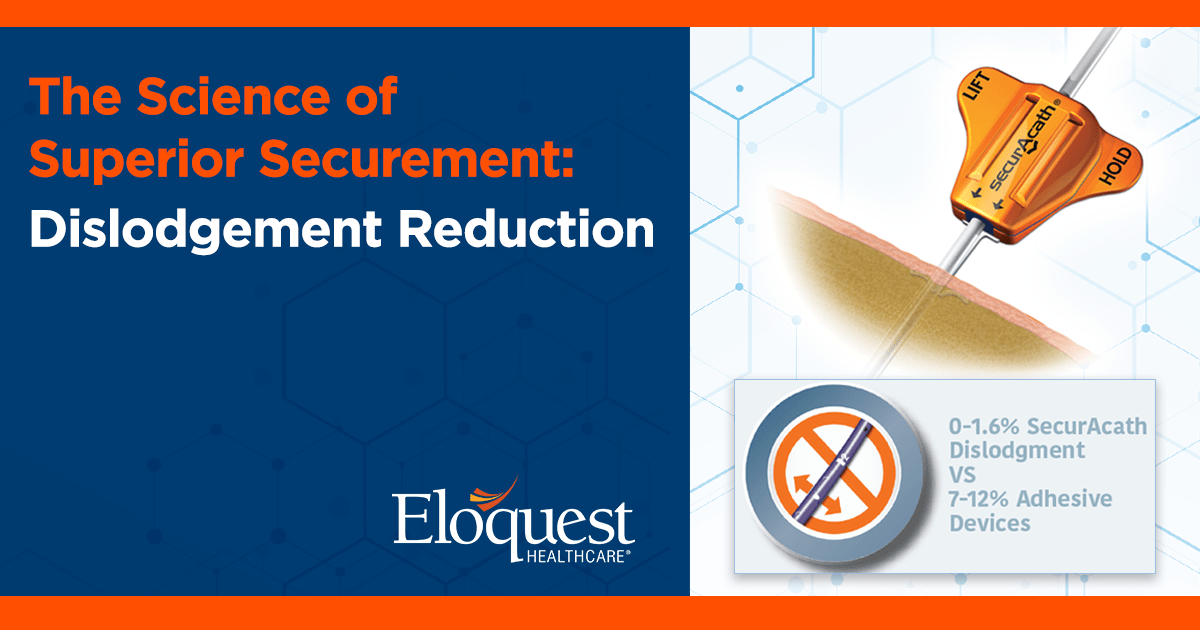
Vascular Access Device Securement and Dislodgement
Most patients will require some form of vascular access care during their hospital stay. In fact, it has been reported that intravenous (IV) access is needed for 60%-90% of acute care patients seen across the nation.1 Best practice guidelines are followed to maximize quality of patient care. These guidelines recommend that all vascular access devices (VADs), including peripherally inserted central catheters (PICCs) and centrally inserted central catheters (CICC), be secured to prevent complications and improve outcomes. 2
Stabilization methods for vascular access devices strive to ensure device integrity, minimize catheter movement at the exit site, and prevent catheter dislodgment. These securement methods must also allow for easy and efficient site assessment. 3
Despite these securement guidelines, device dislodgement remains far too common an occurrence. It can happen in a variety of settings, including during dressing changes if the catheter is not properly secured. A survey of over 1,400 practicing clinicians revealed accidental dislodgement is seen in every setting, every device, and by every type of provider. 68% of clinicians reported observing accidental dislodgement either often, daily, or multiple times daily in their facilities. 4

SecurAcath: Superior Design Reduces Complications and Costs
Catheter dislodgement increases both complications and costs. Dislodgment complications include: 3
- Loss of vascular access
- Forced interruption of therapy
- Unscheduled VAD repositioning
- Increased patient discomfort
- Prolonged hopitalization
- Increased healthcare costs
Dislodgement directly impacts costs for healthcare facilities as well. The average cost to replace a catheter is approximately $1,000 in Interventional Radiology department. 5 Proper securement methods reduce the need for such catheter replacement. While there are a variety of options for securement of intravascular catheters, SecurAcath has been shown to be superior in reducing catheter dislodgement and associated costs.
Dislodgement Rates by Device Type

Just One… Dramatically Decreases Catheter Dislodgement
Eloquest Healthcare is committed to providing solutions that can help improve catheter securement and decrease complications while reducing unnecessary costs. For more information about SecurAcath, please call 1‐877‐433‐7626 or complete this form.
Eloquest Healthcare, Inc. can partner with your institution to facilitate a Vascular Access Device Site Assessment to determine the state of vascular access device & dressing securement for patients in your facility, while providing you and your team with information on your facility’s infection risk, nurse efficiency, and potential product waste. Click here to request a Vascular Access Device Site Assessment today!

References:
1. R.E. Helm, J.D. Klausner, J.D. Klemperer, L.M. Flint, Huang E. Accepted but unacceptable:
peripheral IV catheter failure. J Infus Nurs, 38 (2015), pp. 189-203.
2. Gorski, L. A., Hadaway, L., Hagle, M. E., Broadhurst, D., Clare, S., Kleidon, T., Meyer, B. M.,
Nickel, B., Rowley, S., Sharpe, E., Alexander, M. (2021). Infusion Therapy Standards of Practice,
8th Edition. J. Infus Nurs, 44(1S Suppl 1), S1-S223. doi:10.1097/NAN0000000000000396
3. Brescia, et al, “Subcutaneously anchored securement for peripherally inserted central catheters:
Immediate, early, and late complications.” Journal of Vascular Access (2021) June.
4. Moureau. Impact and Safety Associated with Accidental Dislodgement of Vascular Access
Devices: A Survey of Professions, Settings, and Devices. Journal of Vascular Access 23.4
(2018):203-215. doi:10.1016/j.java.2018.07.002
5. Cardella et al., Cumulative experience with 1,273 peripherally inserted central catheters at a
single institution. JVIR 1996; 7:5-13.
6.McParlan et al, “Intravascular catheter migration: A cross-sectional and health-economic
comparison of adhesive and subcutaneous engineered stabilisation devices for intravascular
device securement.” Journal of Vascular Access (2020) Jan;21(1):33-38.
7. Pittiruti, et al. “Clinical experience of a subcutaneously anchored sutureless system for securing
central venous catheters.” British Journal of Nursing (2019) Jan 24;28(2):S4-14.
8. Zerla et al. “Evaluating Safety, Efficacy, and Cost-Effectiveness of PICC Securement by
Subcutaneously Anchored Stabilization Device.” Journal of Vascular Access 18.3 (2017):238-
242.
9. Dolcino et al. “Potential Role of a Subcutaneously Anchored Securement Device in Preventing
Dislodgement of Tunneled-Cuffed Central Venous Devices in Pediatric Patients.” Journal of
Vascular Access 18.6 (2017):540-545.
10. Hughes, Meinir Elen. “Reducing PICC migrations and improving patient outcomes.” British
Journal of Nursing 23:Sup1, (2014): S12-S18.
11. Paquet, F. et al. “Impact of arm selection on the incidence of PICC complications: results of a
randomized controlled trial,” JVA (2017) 18(5),408-414.
12. Gibson, C. et al. “Peripherally Inserted Central Catheters: Use at a Tertiary Care pediatric
Center,” JVIR (2013) 24, 1323-133.
13. Le Royer, C. et al. “Prospective follow-up of complications related to peripherally inserted central
catheters”, Médecine et Maladies Infectieuses (2013) 43, 350-355.
14. Yamamoto, Alvin J., et al. “Sutureless securement device reduces complications of peripherally
inserted central venous catheters.” Journal of Vascular and Interventional Radiology 13.1 (2002)
77-81.







